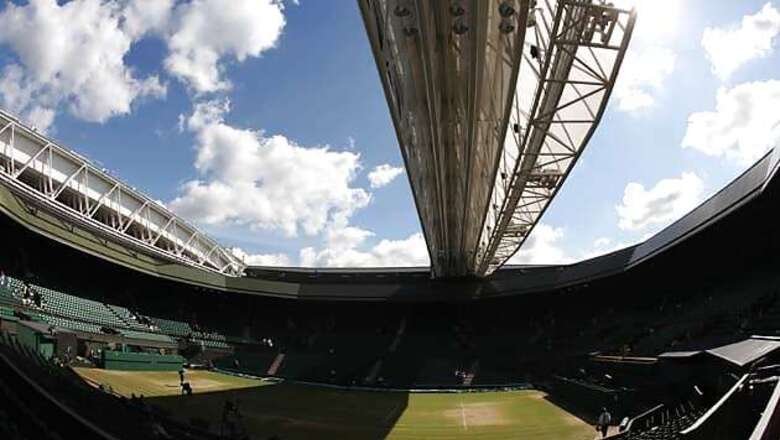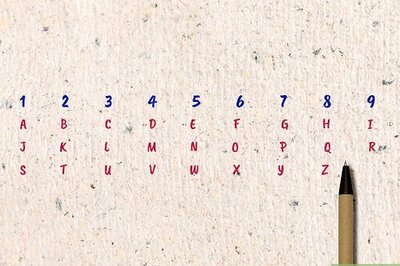
views
A look at 10 of the top topics at Wimbledon, the grass-court Grand Slam tennis tournament that begins on Monday and ends July 7:
1. SERENA WILLIAMS' WINNING STREAK
It's hard to imagine anyone ever having been a bigger favorite to win a Grand Slam title than No. 1-ranked Serena Williams is at Wimbledon this year. She comes in as the defending champion; she's on a 31-match winning streak, the longest single-season run in women's tennis since her older sister won 35 in a row in 2000; she's 74-3 since the start of Wimbledon a year ago. Williams has claimed three of the last four major titles to raise her career total to 16 - two shy of Chris Evert and Martina Navratilova.
2. WHO CAN CHALLENGE WILLIAMS?
There are, to be sure, other women capable of walking away with the trophy from the All England Club, starting with Maria Sharapova, who won the title in 2004 by beating - you guessed it - Williams in the final. But although Sharapova put up a fight in this year's French Open final against Williams, she really didn't represent much of a hurdle and has lost the last 13 times they've played. Petra Kvitova, the 2011 champion, seems to have the grass game figured out; No. 2-ranked Victoria Azarenka is a two-time semifinalist; Agnieszka Radwanska and Marion Bartoli have been the runner-up. Still, hard to imagine any of them beating five-time champion Williams if she's healthy.
3. FEDERER'S BID FOR 8
Until this year's French Open, no man had won eight titles at the same Grand Slam tournament. Rafael Nadal got No. 8 in Paris, and now Roger Federer can try to match that accomplishment at Wimbledon. Federer is the defending champion, and he's still as good as it gets on grass; he finally ended a 10-month title drought by winning a tuneup tournament on the surface at Halle, Germany. Wimbledon is the major tournament that people figure he's most likely to win if he's going to add to his record total of 17 Grand Slam titles.
4. MURRAY AND 1936
Andy Murray is no doubt tired of hearing the name "Fred Perry" and the year "1936" - and we all will hear those words over and over again, so long as he keeps winning matches during the fortnight. Murray once again will try to give Britain its first male champion at Wimbledon since, well, you-know-who in you-know-when. A year ago, Murray became the first British man to even reach the final since Bunny Austin in 1938, then lost to Federer in four sets. Then Murray won the Olympic singles gold medal at the All England Club, beating Federer, of all people, in the final. And in September, at the U.S. Open, Murray became the first British man in 76 years to win any Grand Slam singles title. He pulled out of the French Open with a back issue, but won the grass title at Queen's Club, so all appears fine.
5. THE USUAL SUSPECTS
Nadal and No. 1-ranked Novak Djokovic have combined to win 11 of the most recent 13 Grand Slam titles. Those two plus Federer have collected 31 of the past 33, and when you add in Murray (who won one of the other two), that quartet sure seems likely to produce this year's champion at the All England Club. Djokovic won Wimbledon in 2011, and Nadal has two titles plus three runner-up finishes; neither played a tuneup tournament on grass, but that might not matter. Will be worth watching how Nadal, who's seeded only fifth, fares a year after his surprising second-round loss to Lukas Rosol, who was ranked 100th at the time.
6. THE "OTHER" GUYS
There are other men capable of making deep runs and maybe even pulling off a significant upset in the second week - Grand Slam runners-up Jo-Wilfried Tsonga and Tomas Berdych, 2009 U.S. Open champion Juan Martin del Potro, and good servers Marin Cilic and Milos Raonic all come to mind - but really, who are we kidding here?
7. NO MORE RODDICK
For years, Andy Roddick showed up at the All England Club with his rat-a-tat serve and big forehand and wiseacre attitude and outplayed pretty much everyone except Federer. And that meant Roddick came close as can be, but never won Wimbledon, losing to Federer in three finals, including a 16-14 fifth set in 2009. With Roddick retired and off to a TV career - perfect fit, right? - the question becomes whether any U.S. man can stick around for Week 2. Because it still could be a while before the end of the decade-and-counting wait for an American man to win a Grand Slam title for the first time since Roddick at the 2003 U.S. Open. After all the angst about clay, grass is the type of speedy surface that's supposed to reward the typical American style of play; big servers Sam Querrey and John Isner (Mr. 70-68) will see if it does this year.
8. LIKE A FINE WINE
Tennis' older set is doing just fine, thank you. Whether it's the 31-year-old Williams (the oldest No. 1 in WTA rankings history) or the 31-year-old David Ferrer (at the French Open, became the oldest first-time Grand Slam finalist since 1973) or the 35-year-old Tommy Haas (the oldest quarterfinalist at Roland Garros since 1971), age is suddenly nothing but a number. There are 12 players who are at least 30 ranked in the WTA's top 100; 15 years ago, there were only three. Last year, Federer became the first thirtysomething man to win Wimbledon since Arthur Ashe in 1975. Federer turns 32 this August.
9. POUND FOR POUND
All of those face-to-face lobbying efforts by the top men in the sport are paying off in a big way at the Grand Slam tournaments. The total prize money on offer at Wimbledon is jumping about 40 percent from 2012 to 2013, going from 16.1 million pounds (about $25 million) to 22.6 million pounds (about $35.5 million). And the men's and women's singles champions will each earn 1.6 million pounds (about $2.5 million) this time, rising from 1.15 million pounds (about $1.8 million) last year.
10. RAIN, RAIN, GO AWAY
Weather and forecasts are always popular conversation topics in England, and that only increases during the tournament known simply as "The Championships." While long-range predictions are for a dry first week this year, even if rain does arrive, the retractable roof on Centre Court allows for play - and there are plans to add a movable cover for Court 1 by 2019. If the roof on the main stadium is used this year, it surely will reprise the debates of 2012, when there was much discussion about altered playing conditions indoors for Nadal's loss to Rosol, and Federer's victory over Murray.



















Comments
0 comment